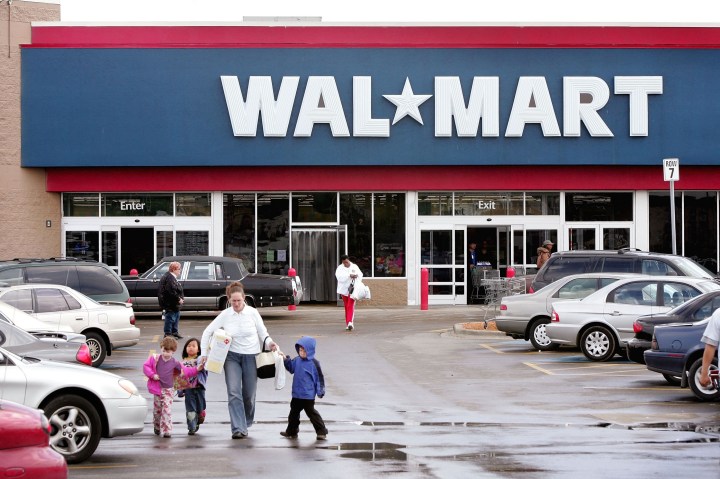
Why do Walmart shoppers enter on the left and exit on the right?
Share Now on:
Why do Walmart shoppers enter on the left and exit on the right?

This is just one of the stories from our “I’ve Always Wondered” series, where we tackle all of your questions about the world of business, no matter how big or small. Ever wondered if recycling is worth it? Or how store brands stack up against name brands? Check out more from the series here.
Reader Rob Szarka from Lawrence, Kansas, asked:
All the Walmart stores I’ve seen have the entrance door on the left and the exit door on the right. This seems to be a poor fit for the American convention of “driving” (and walking) on the right, but I assume that a master of logistics like Walmart has a good reason to do it this way. Is there a method behind the madness?
Think about the way highway entrances and exits operate.
Frank Liu, an associate professor of business administration at the University of Illinois Urbana- Champaign, said you can apply that same logic to the flow of foot traffic at Walmart, the country’s biggest retailer by revenue.
In order to handle its high volume of customers, Walmart needs a lot of cashiers that are strategically placed at the front of the store between two sets of entrances and exits, Liu said.
A view of a Walmart floor layout:

On the right side of the store at many Walmarts, entrances will be on the right and exits will be on the left. The typical orientation. But on the left side of the store, exits will be on the right.
“The best doors for them to exit are through the doors near the cashier, the inner sides,” said Liu, noting that they’ll be pushing out shopping carts loaded with items. “The entering customers use the other doors so the entering traffic does not interfere with existing traffic.”
Liu said retailers that don’t have heavy traffic and whose cashiers are located at the corners rather than the middle-front of the store, the doors will be designed in the opposite way.
So how do you explain this Walmart Neighborhood Market in Downey, California, which has one entrance and exit, yet still maintains the left entrance/right exit orientation?
Smaller Walmarts like this one just need one entrance and exit, Liu said, and foot traffic inside might run clockwise with grocery shoppers in mind because they tend to purchase their items quickly and leave. A 2007 study by the Association for Consumer Research found that customers in stores with a clockwise layout “evaluated the store better in terms of perceived ease of orientation and value for money.”
But not every Walmart hews to this format, with some of its neighborhood market locations that keep its entrances on the right and exits on the left.
There are different theories about which store layout is better. Retailers encourage customers to turn right when they enter the store because that’s most people’s instinct, a retail branding professional told Entrepreneur. Shoppers will then tend to move counterclockwise around the store. And because clockwise patterns enable greater efficiency, store owners opt for the opposite pattern so that customers can spend more time walking around the store.
Other exceptions include Costco, which has some stores running clockwise and some counterclockwise. A Reddit user recently polled other users about how their local Costcos are set up. One poster said going to the “backwards” clockwise store on the other side of town was like being in “the Upside Down,” calling it “the uncanny valley of bulk shopping.”
But other users prefer that orientation, with one poster stating they “felt more comfortable at clockwise Costcos.”
“[Costco prefers] a right-hand rule for access to their racetrack, but they are also very savvy on the real estate deals,” said Stan Laegreid, the senior vice president of design at Kemper Development Co. and a former principal at an architecture firm that designed Costco warehouses. “Sometimes the ability to place the store in the desired location with maximum parking near the entrance will lean the entrance to the left, so you end up doing the racetrack backwards. It still works.”
Mark Landini, creative director at design consultant Landini Associates, said that Walmart is the biggest brick-and-mortar retailer in the world — a distinction the company has held for decades — which means it gets to choose where it builds its stores and how to build them. Walmart’s 2020 revenue was $559 billion, beating out its e-commerce rival Amazon, which pulled in $100 billion.
Mark Cohen, a professor of retail studies at Columbia University, agrees that Walmart’s resources gives it the power to build its own stores and avoid co-tenants.
“They are masters of their own destiny in most cases, having purpose-built their stores from scratch, as opposed to occupying someone else’s box or having to conform to someone else’s development,” Cohen said.
But in the future, right entrances or right exits may not even matter.
Amazon Go, the retail giant’s foray into the grocery space, doesn’t use checkout stations, Landini said. No checkouts means you don’t need the physical space to accommodate them, which in turn means you won’t need a single dedicated entrance or exit since “you’ll be able to enter or exit wherever you choose,” he explained.
There’s a lot happening in the world. Through it all, Marketplace is here for you.
You rely on Marketplace to break down the world’s events and tell you how it affects you in a fact-based, approachable way. We rely on your financial support to keep making that possible.
Your donation today powers the independent journalism that you rely on. For just $5/month, you can help sustain Marketplace so we can keep reporting on the things that matter to you.












